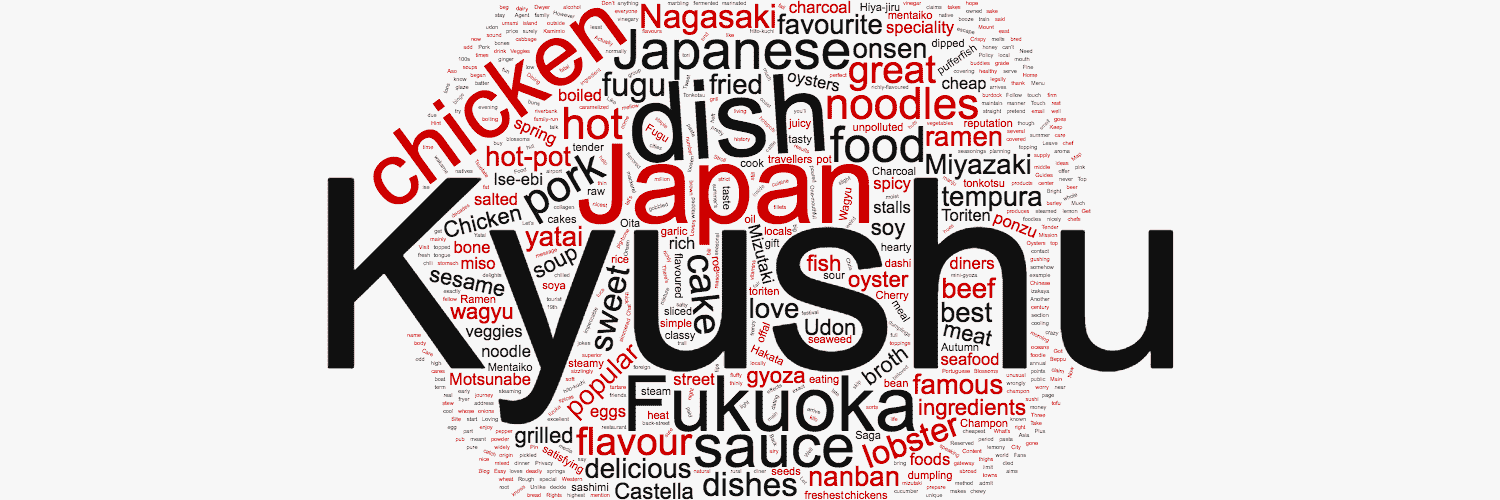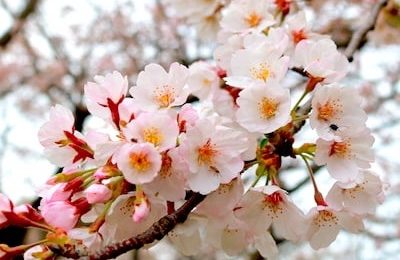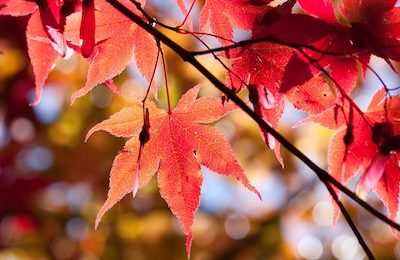Cost-effective Kyushu cherry blossom guided tour. Best spots, great wonderful, wonderful nature. Details here.

The food in Kyushu has an excellent reputation throughout Japan. The Japanese recognize quality ingredients and delicious fare when they see (and taste and smell) them. Except for Tokyo, you’ll find more restaurants in Kyushu per person than any other part of Japan, and more even than Hong Kong and Singapore. In fact Trip Advisor currently lists almost 10,000 Kyushu restaurants. The culinary delights of Kyushu will be a big part of your vacation here.
Let’s take a quick journey through Kyushu’s most famous speciality dishes.
one of the country’s culinary hotspots
Japan Rough Guide
Tonkotsu ramen (pork bone noodles)
Tonkotsu ramen is Kyushu’s most famous dish. It originated in the Hakata district of Fukuoka so is often referred to as ‘Hakata ramen’. Look out for the Hakata ramen signboard outside speciality restaurants:博多ラーメン. It’s a cloudy milky-looking noodle dish in an oily pork-bone broth. It’s usually flavoured with soy sauce or miso. The essential point of tonkotsu ramen is that it’s simmered for hours. As it simmers the marrow oozes from the cracked bones. This is what makes it so creamy, thick, nutritious and delicious. The noodles are thin and white (not made with egg). In most ramen shops you can ask for the noodles to be cooked for the softness or chewiness you prefer. If you’re not sure ask for ‘futsu‘, which means medium. That’s what my Fukuoka-native wife prefers. If futsu isn’t for your liking, next time you can ask for ‘yawa’ (soft) or ‘katame’ (firm). After you’ve finished your first bowl you can usually ask for extra noodles for your broth for a small extra charge. This is what makes it such a hearty, filling and inexpensive meal. Tonkotsu ramen isn’t a fancy dish and the toppings are fairly simple. In addition to the sliced pork it’s served with you can usually choose from seaweed, green onions and pickled ginger toppings though this varies from shop to shop. Tonkotsu ramen is a much-loved dish throughout Japan. Don’t miss a bowl while you are in their birthplace in Fukuoka. Ideally you’ll slurp them at one of the riverside yatai food stalls.
Kyushu wagyu (beef)
Wagyu beef is the highest grade beef that money can buy and the best is produced in Kyushu. The prestigious “wagyu olympics” are held every 5 years. In the most recent competition in 2017 the Kyushu prefectures of Kagoshima, Miyazaki and Oita grabbed the three top spots. The beef comes from carefully selected cattle, raised in a very specific (slightly odd) manner, in pure and unpolluted environments. The most well-known characteristic of wagyu is the marbling of the fat. This results in a tender, richly-flavoured meat that melts in the mouth. Wagyu has a sweet and mellow aroma. In Japan there are strict regulations to maintain the quality (and limit the supply) of wagyu. Wagyu is usually eaten as steaks in the west. Here in Japan it’s more often found in shabu shabu (hot-pot), sukiyaki (pan-fried hot-pot) or teppanyaki (griddle-cooked). If you want to try it ask my wife for her favourite wagyu restaurant in Fukuoka.
Fugu (pufferfish)
You’ve probably heard about the fearsome reputation of fugu (pufferfish). Prepared wrongly and it can be fatal. In fact 100’s of fugu diners in Japan have died over the decades. Only licensed chefs can legally prepare this dish. Don’t worry too much though. Thousands of tons of fugu are eaten each year in Japan and it’s delicious. Fugu is an expensive dish to be eaten on special occasions in fugu specialty restaurants. It’s a specialty of Kyushu and neighbouring Yamaguchi which both share the same unpolluted waters of the Bungo Channel. It can be prepared in many ways, most commonly sliced paper-thinly and eaten raw as sashimi. It’s often served in intricate patterns to resemble chrysanthemum blossoms. The thinness makes it translucent allowing it to beautifully complement the porcelain dish it’s served upon. Let us know if you want to try fugu while you in Kyushu. It’s a pretty unique dining experience and a great story to tell when you get back home. You can emphasise the bit about your lips tingling (however this is more likely caused by the sauce rather than a hint of poison).
Hint: Two things a classy diner doesn’t do when eating fugu. One, make jokes about the deadly effects. Two, pretend to be shocked (or really be shocked) when the heft bill arrives. Be cool, be classy, and enjoy the whole experience.
Motsunabe (offal hot-pot)
Motsunabe doesn’t sound great but apparently it’s delicious. The Japanese love it. Fukuoka is the birthplace of motsunabe but it became a must-have food throughout Japan following a media frenzy in the 1980’s. Motsunabe is a hot-pot stew made with beef or pork offal. It’s flavoured with soy sauce or miso and lots of garlic. It’s cooked at the table in a boiling pot with veggies and noodles going in first. Noodles are added as serving time comes near. This is useful to know because you’ll be cooking it yourself at the table. It’s low in calories and high in vitamins and collagen. This makes it a healthy dish especially popular with female diners. Restaurants serving motsunabe are packed on Fridays and Saturdays. Can you guess why? It’s because for many people the next day will be a day off work. This means you don’t have to worry about breathing your stinky garlic breath over customers or fellow workers.
Champon (pork noodles)
Champon is a boiled noodle dish from the Kyushu Prefecture of Nagasaki. It’s a favourite for my wife’s family when we eat out together. Champon is an everyday dish for the common people. Pork, seafood, fishcake and veggies are fried and used in a chicken and pig-bone soup. Noodles are added to make a hearty, filling meal. The noodles are thicker and yellower (made with egg) than the white, thin ramen noodles. Because there is a wider variety of ingredients than ramen many people feel it’s like a complete meal in a bowl. Like many Kyushu animal-bone dishes, the best champon is boiled for hours to produce a rich, satisfying (and umami) flavour.
What’s Umami?
It’s the 5th taste that humans can recognize (the others are sweet, sour, salty and bitter). Umami was first isolated by a Japanese scientist about 100 years ago. This led to the development of MSG – the ultimate umami kick. It’s a rich savoury taste and natural sources include bone-broth soup, parmesan cheese, and tomato bolognaise. Brits like me get our umami fix from Marmite.
Udon (noodles)
The Hakata area of Fukuoka claims to be the birthplace of udon noodles. However so do many places in Japan and in fact they probably originated in China. Wherever they were born they have stood the test of time. Udon have been slurped in roughly the same form for a thousand years or more. Udon are thick, soft, slightly chewy and very satisfying wheat noodles. They are served hot in dashi (a tasty clear soup) or cold in a dipping sauce. When they are served in dashi any number of toppings are added. Most common toppings are wakame seaweed, fish cakes, or ebi (prawn) tempura. Actually you can’t really call them ‘toppings’ because they are an integral part of the dish but I can’t think of a more suitable word. Udon is a cheap and delicious Japanese staple food. Kids here start eating it at an early age and keep going into their golden years. It’s my favourite go-to food when I need something quick, tasty, cheap and satisfying. I generally go for the very basic dish of wakame udon. This is simply udon noodles in soup with added seaweed. I usually sprinkle on a bit of chili powder and that’s it. Lunch without needing to over-think. Being the old-fashioned sort I especially love the udon shop near my house where the noodles are hand-made. Kyushu udon noodles are softer than normal and my wife describes them as having an ‘amusing’ texture as they slip down. Kyushu noodle broth (dashi) is milder than most other places. Burdock root topping is a quintessentially Kyushu topping and Japanese visiting from other islands will always ask for this when they come. You can too, just ask for gobo.
Oysters
Fans of oysters will love a trip to Kyushu. Visit a fancy restaurant in Europe or the States and pay $10 for an oyster if you want. Or visit Kyushu and pay $10 for a kilo. The oyster huts in Itoshima (west Kyushu) are most famous. However this is more due to smart marketing than anything else. The nearby prefectures of Nagasaki and Saga have their own excellent oyster huts and have done for longer than Itoshima. Wherever you have them make sure you come in oyster season (winter). Oyster huts offer not only the freshest oysters but a fun experience too. They are locally owned, family-run and simple in style. They generally aren’t eaten raw European-style. Instead you’ll cook your oysters at your table over a charcoal grill. You can get other seafood too and everything is fresh off the boat. You can add soya sauce, lemon or (my favourite) ponzu. It’s a kind of lemony, vinegary sauce. We’ll be happy to work a west Kyushu oyster hut experience into your vacation itinerary. It’s a nice day out in a pretty rural area of Japan.
Hito-kuchi gyoza (dumpling)
You’ve probably heard of gyoza, right? It’s a kind of Chinese dumpling. They can be cooked in many ways but are usually steamed or fried. One-mouthful (hito-kuchi) gyoza are a specialty of Kyushu. As the name suggests they are mini-gyoza that can be gobbled down in a mouthful. Crispy on the outside, juicy in the middle, the most common filling is pork and cabbage but anything can go inside really. They are eaten with a dipping sauce which you mix yourself at the table. Most common sauces are soya sauce, vinegar, chili oil and perhaps sesame oil. Hito-kuchi gyoza is a casual food and goes well with beer.
Mizutaki (chicken hot-pot)
Mizutaki is another dish first served in Kyushu. It became popular in Fukuoka around the end of the 19th century. Mizutaki is a chicken hot-pot. It’s made from chicken meat and bones, boiled in a pot, with added veggies and tasty broth. It’s usually cooked at the table and is great meal for a family or a group of friends. Everybody can tuck into this hot, steamy dish. You’ll often find mizutaki served at quite fancy restaurants with the staff smartly dressed in kimono.
Toriten (deep fried chicken)
Toriten began it’s life in Oita prefecture and is still mainly found there. You are probably already familiar with the Japanese dish of tempura (battered deep fried seafood or veggies). Toriten is simply chicken tempura. This is what makes it unusual because chicken isn’t normally a tempura ingredient. It is found in Oita because so many chickens are produced there. Toriten is served sizzlingly hot, straight from the fryer. If you visit the popular onsen (hot spring) town of Beppu in Oita Prefecture you can easily find toriten there.
Chicken nanban (sweet and sour chicken)
Chicken nanban is another deep fried chicken dish. It’s usually made with chicken fillets and has a sweet and sour, slightly salty, spicy, flavour. You’ll often find it served with tartare sauce. Chicken nanban started life in a small restaurant in Miyazaki prefecture. The term ‘nanban’ at the time meant something foreign, slightly weird, but somehow desirable. It spread throughout Kyushu but is still most popular in Miyazaki. It’s a well-liked dish, juicy and full of flavour.
impeccable local ingredients, beautifully-prepared, at very fair price points
Chris Dwyer, Fine Dining Lovers
Charcoal grilled chicken
Charcoal grilled chicken is a speciality of Miyazaki prefecture in Kyushu. Much care and attention is paid to how the chicken are bred and raised. The chickens are widely recognized as of superior quality. In fact over 100 million chickens a year are sold from Miyazaki to the rest of Japan and worldwide. The chicken thighs are salted and grilled over charcoal. The meat is rich in flavour but can be a bit chewy and tough which is why it’s cut into small pieces before serving. Honestly speaking charcoal grilled chicken doesn’t look great, a bit burnt and with bits of charcoal. It’s still however a popular dish in Miyazaki.
Hiya-jiru (chilled soup)
Hiya-jiru is a dish from the Miyazaki Prefecture of Kyushu. Unlike many of Kyushu’s most famous cuisine this dish is rice-based rather than noodle or hot-pot. The main ingredients of hiya-jiru are grilled mackerel, sesame seeds and miso (fermented soya bean paste). The flavour comes from the miso and from the seafood broth (dashi). This cold soup is poured over cold white or barley rice or simply drunk as a soup. It’s often served with other ingredients such as tofu and cucumber. It’s a cooling dish for a hot summer’s day.
Looking for inspiration?
Contact ‘Hakata Foodie‘ to enjoy a meal in Fukuoka with a knowledgable guide and amiable companion. Get an insiders introduction to some of the hidden Hakata restaurants.
Mentaiko (fish roe)
Mentaiko is red or pink spicy salted fish roe (eggs) from Fukuoka. Japanese go crazy for it. Whenever I travel from Japan my buddies living abroad beg me to bring some back. The flavours of mentaiko come from the spices and seasonings added and everyone will have their favourite producer whose taste they love. It can be quite spicy. It’s eaten simply with rice, mixed into pasta dishes or sold at bakeries as mentaiko bread. You’ll often see it served as a sushi topping in revolving sushi shops (but not at proper sushi restaurants). Honestly speaking, it’s not for me but my Kyushu-native wife loves it.
Ise-ebi (spiny lobster)
Ise-ebi is a kind of lobster (spiny lobster, to be exact). From September to November there is an annual ise lobster festival along the east coast of Kyushu covering the prefectures of Oita and Miyazaki. These areas are renowned for the quality and abundance of their spiny lobster catch. You’ll find them grilled over charcoal, salted in soups or simply served raw as sashimi. The meat is firm and sweet with a rich flavour. Ise-ebi lobster from Kyushu are distributed throughout Japan but you’ll find the freshest and cheapest here in Kyushu.
Onsen (hot spring) food
This isn’t really a dish but rather a method of cooking. It’s common in Kyushu because of the abundance of onsen (hot springs) here. For 100s of years the locals in Kyushu have used this natural heat and gushing steam for cooking. Actually you can cook most things with heat and steam but the most common onsen foods are eggs, veggies and manju (sweet bean buns). If you visit the onsen town of Tsuetate, for example, you will find public areas to take your food for steaming. A trip to Mount Aso is never complete without an onsen egg.
Castella cake (sponge cake)
Castella cake is a speciality of Nagasaki prefecture in Kyushu. It’s a sponge cake of Portuguese origin. The top of a Castella cake is covered with a thin caramelized glaze produced by the baking process. The body is light and fluffy. It’s moist, quite sweet and delicious with a slight honey flavour. If you are from Europe or the States you will probably already be familiar with this kind of cake. It’s less common in Asia and for this reason is a popular gift. You’ll find it everywhere in Nagasaki and nicely wrapped as a gift at Fukuoka airport departure terminals.
Yatai (street food stalls)
We can’t talk about food in Kyushu without mentioning yatai (street food stalls). The Fukuoka yatai are famous throughout Japan. Bright and airy in summer, hot and steamy in winter, they are the perfect place to eat, meet and drink. No trip to Fukuoka is complete without at least one yatai dinner. They arrive in early evening, stay late into the night, and are gone by morning. Stroll along the riverbank in the centre of Fukuoka and decide which yatai takes your fancy. They serve all sorts of dishes. Especially popular are yatai serving Fukuoka’s most famous dish of tonkatsu ramen. It’s a great place to meet the Kyushu locals. You’ll be elbow-to-elbow and the booze will surely loosen their tongue.
Japanese food with Tender Loving Care
Get in touch now to start planning your vacation in Kyushu. If there are any particular foods you want to try mention this when you contact us. We’ll make sure to work that into your Kyushu travel itinerary. Me and my wife are both great foodies. We’ll be happy to share our favourite restaurants, street stalls and back-street diners.
In fact if you decide to use our trip planning service we hope we can share a table with you at one of our favourite Kyushu restaurants.
Author disclaimer
Kyushu Journeys is run by me and my wife. I’m an expat Brit living in Japan and my wife is a Kyushu native from Fukuoka. She knows her food, I mean she really knows her food. In fact for years I’ve tried to persuade her to open a restaurant here. She refuses outright, probably wisely (if you know anybody in the restaurant trade you will understand why). I’ve haven’t eaten meat for more than 30 years. I didn’t eat fish or seafood for a long time too but my wife persuaded me, after years of dogged persistence. Thank God she did. The seafood in Japan is unsurpassable and it’s opened up an amazing world to me. After a traumatic childhood experience (don’t ask) my wife doesn’t eat chicken. The point of this slightly long-winded preamble is to say that everything here is written by me based on my wife’s first-hand experience and knowledge. Only the chickeny bits are gathered second-hand from what she has read, and input from her friends and family.
Author request
If you have anything to add about food in Kyushu please share it below. Perhaps you have a favourite restaurant or want to ask for a recommendation. You may know a dish we missed. You could disagree with something written above, have a question to ask or a comment to add. Let’s share our experiences about Kyushu cuisine and widen our culinary world.




I will be in Fukuoka for 2 nights and 1 day before taking the Seven Stars in August. I’ve never been to Japan, do not speak the language. I’m a solo traveler. How can I try the Street food in Fukuoka? Do any vendors speak English? Are any signs in English? I do like meat and vegetables, just ok with fish. Are there places to sit and eat? I have read that people do not walk around eating, except maybe ice cream.
Many thanks
Hi Mary, sounds like a great adventure! Suggest you try the “Yatai Experience” at Hakata Foodie [https://www.hakatafoodie.com/]. They will arrange English speaking guide to accompany you on your street food experience. Hope this helps, Simon (Kyushu Journeys)
Hi, do you have any suggestions for Kyoto restaurants that feature vegetables? We are pescatarians and so many of the local dishes feature meat.
Thank you!
Hi Lorri, I’m a pescatarian myself living in Japan and usually don’t have any problems finding seafood (non-meat) dish unless it is a meat specialty restaurant (ramen, yakiniku etc). Unfortunately we only operate on the island of Kyushu so don’t have any suggestion for Kyoto, sorry.